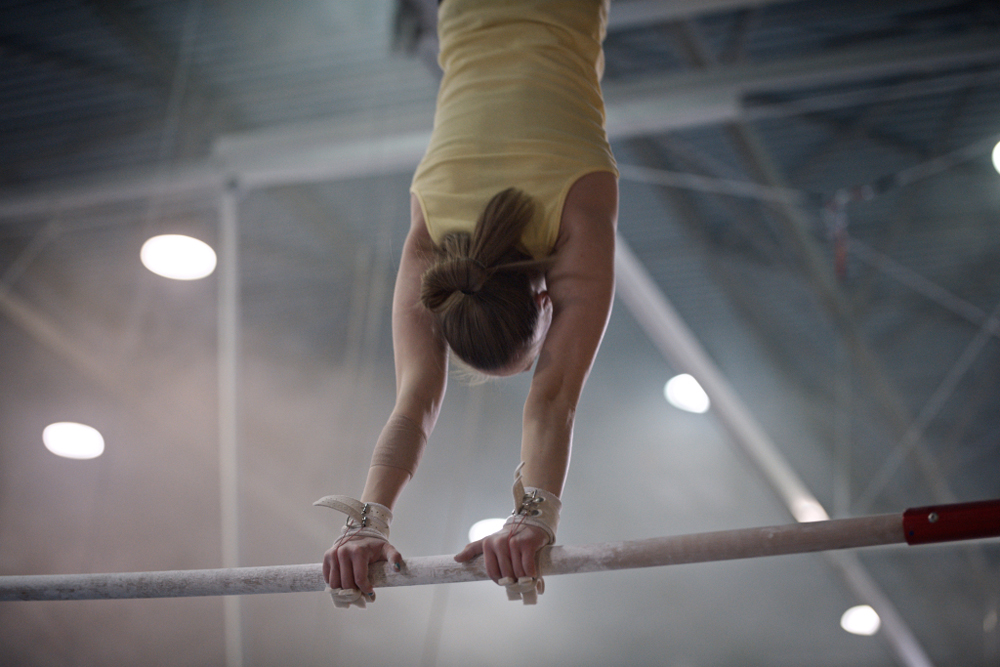Elie Grappe was at the European Gymnastics Championship in Bern, Switzerland when he first saw Anastasiia Budiashkina, the young woman from Ukraine who would come to star in his debut feature “Olga,” unable to take his eyes off her precisely because she wouldn’t look at him.
“She was competing for the junior team and I think we were announced that two people were here to search for gymnasts for a movie and everybody turned to us,” recalls Grappe. “Everybody but Anastasia who was so concentrated on what she was doing and she was not giving a shit about us. Immediately, she was very touching. There was some kind of intensity with her that I didn’t want to control at all.”
It is only one reason among many now that “Olga” is all but impossible to look away from now, set during the days leading up to the Maidan revolution in Kiev in 2014 where sustained protests in the streets led to the ouster of then-president Viktor Yanukovyych, widely thought to be sympathetic to Russian interests as the expense of the nation’s citizens. Grappe had learned of what was unfolding from a musician who was living abroad during the unrest and deeply pained by what she was seeing, and as he started to do research, a story began to take shape of a reporter who sends her daughter off to live in safety when her own life is in peril as she gets closer to uncovering Yanukovych’s corruption, knowing their child’s unique ability can afford them safe haven elsewhere.
Still, after Grappe changed the milieu from a conservatory to a gym, it is clear that for all of the incredible skill that leads Olga to be adopted by the Swiss National Team, there is nothing clean about her move except the exercises she continues to practice on the parallel bars and pummel horse, with her strength and concentration tested far more by news from home than her own physical limits. Besides feeling eerily prescient as Russia’s current invasion of Ukraine roils on, “Olga” is viscerally gripping in other ways, likely due in no small part to Grappe’s commitment to authenticity, enlisting his cast from the real world of gymnastics that can pull off performances both for the screen and on the mats and drawing on years of research that brings clarity to the parallel lives its lead character feels she’s leading, stranded in a country where she can’t speak her native tongue.
When his own grasp of cinematic language is already so strong, Grappe has crafted a drama that can cross borders far more easily with “Olga” and in fact, it wasn’t only on screen during its premiere at Cannes last summer where one could see people doing backflips. With the film now making its way to American shores, the director spoke about the evolution of the film over time as well as his own artistic pursuits and how he captured the physicality of his ensemble so intimately to see inside their emotional state.
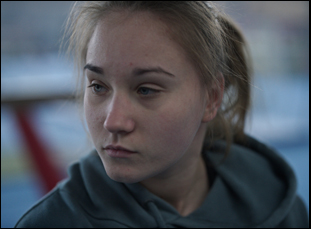
It was because I had this encounter with a violinist from my documentary film and she was telling me her story about how she arrived from the Ukraine to Switzerland and how her practice was affected by what was going on. It was a very touching story but I just did work before this movie on a concert movie about music academies and as I had everything to learn about the Ukraine, I didn’t want the practice of Olga was something I already knew too much, so I wanted to choose a practice that I had to learn as much as for Ukraine. That’s the main reason for this choice. But after I realized all the connections between the two and that can be done through cinema. The sound of the gymnastics is very close to the sound of the revolution, full of metal bars and detonation. It’s as if [in those] first images when Olga comes back to training, she has in her ear those sounds of the revolution coming with her somewhere.
You actually were a musician before becoming a filmmaker. What made you change your artistic practice?
I was playing the trumpet in a conservatory for about 10 years and I was in a special program at the conservatory, so I studied there for a long time, but I knew already I wanted to make films. My parents are not from the cinema world and they are teachers, so [I was] turning around what could become my tools to become a filmmaker, and I did a bit of theater and I studied very intensively in music, but now I think that a film is a bit like composing. You have to find the right nuance and it’s not completely connected to the process of scriptwriting. Scriptwriting and dramaturgy occupies a lot of space in the research of fiction-writing, but it has to not be the only driving thing. That’s where I think music helps me a lot. I refer to the rhythm of things and to the inner composition, and it helps me at the moment we are thinking about the colors of the film, the costumes, the light, the sets – it’s very close to the composing process.
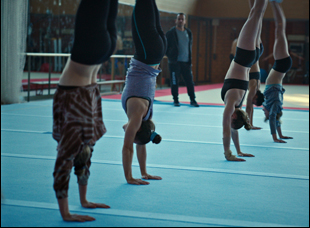
It was very early in the process of the writing because it was a recent story at the time and very close to the real life of the people I was meeting to learn about Ukraine. I went around 12 times during the writing process and I realized the first time I went, I didn’t want to [dramatically recreate] barricades, so I told myself that the use of archives could contribute to the story of Olga, which is a fiction. Her practice is also suddenly confronted to a [bigger] thing and it was a question of [whether] my fiction going to survive those images [of reality]? That’s also why the first time it’s because Olga is watching [images of the war on a small TV screen], but little by little they are somehow occupying the space of the film [eventually taking up the full frame].
That mix of reality and fiction would seem to extend to how the production was set up generally when much of your cast really came from the gymnastics world. What was it like to try to capture what they could bring to this?
We had to be mostly careful on the rhythm of the gymnasts because what they do is very dangerous and mostly on the bar, it’s a very dangerous practice. The body has to stay warm between the tricks because it’s mostly when the body is getting colder that it can be dangerous for the gymnast. They can break something. So we preferred to make longer takes by playing the action [in the scene] several times, so in one take, we were playing one, two, three, four times the action of the scene. There was less break in this process. For example, after all the moments they’re preparing themselves [for an event], it’s almost documentary. The first time [Olga] arrives in the gym, there is this very settled shot when she enters, but after there are several shots where she’s preparing [all the other gymnasts] are approaching, so we had to be very flexible in the [takes] we were using. Inside one [shot], there could be three different [takes].
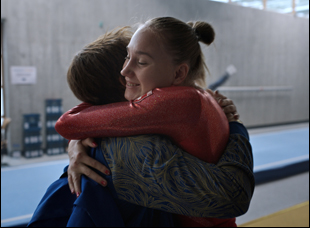
It was tricky, but I don’t know if it was more tricky than any other filmmaking. We had to be confident that we were building a very, very precise [shotlist] of what we were wanting to shoot and we were working for hours on every little thing, but it had to be disturbed by Anastasiia. I chose Anastasiia because I knew she was going to explode everything I was asking her — that’s what we wanted, but that something would survive from these very precise things we had in mind and it would be enhanced by the real experience of the athlete. I wanted to invite her to be part of this character because she had very boiling [intensity], which was way above what I’m able to imagine for the character, and we were asking a lot of her during shooting, but at the same time, there was always a space for what she truly is — her emotion, her reactions, and it’s her own words when she improvises in the Ukrainian and Russian language. [Generally, the cast in this film] have way more experience than me in what they do and are way better actresses than professional actresses who play gymnasts, so we had to be confident that they could occupy this space completely and it was a real balance between extra precision and opening the doors to what they were proposing.
When you talk about reactions, it’s always interesting to me when actors have to engage with screens since often you can’t actually depict those conversations naturally with the demands of the film. What was it like to make her calls to Ukraine work in the film?
The calls are all made truly in Switzerland to Ukraine, so we had a team there who was preparing some sets there and they were really playing as real [calls]. For example, the first [call] with the mom, I think we were gaining a lot by having the real [calls] because all all the [distortion] from the connection, from things like [the pixelation], adding a [feeling] inside the sequence.
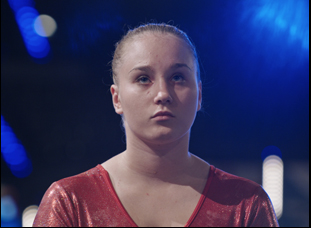
It’s actually a very hard scene to prepare because we have to be extra [careful], three times more precise than we are already with all the rest. Everybody has to trust us and the [cinematographer] of the movie and I are quite young, so we are working with a team that is more experienced, but once we are on set and everything is prepared, it’s a very fun scene to shoot because we suddenly have two nights to shoot 40 seconds of the film. It’s a huge team for this scene, but everybody knows exactly what to do and everybody was very excited to shoot finally this sequence that we spent three years-and-a-half to imagine.
It’s such a big accomplishment in general. Was making a feature what you thought it would be?
I think I’m very Cartesian, going one step after another and before preparing to do a first feature, I was worried about the time that I would spend on this project. Now I realize that I never stopped working and it took exactly the time it had to be taken. We were stopped by COVID, but even during the COVID stop, we had to trust very much we were going to finish and not be too paranoid. Everything went on its own rhythm and now I’m less afraid to spend my next five years on my project, so maybe for the people who are going to prepare their first feature, I can say this – it sounds like a mountain, but you have to choose the right questions. There are bad questions and there are things that are dependent on you and things that are not dependent on you, and [just] doing a script that you yourself like very much is already such a thing that you have to fight for the right questions.
“Olga” opens on July 8th in Los Angeles at the Laemmle Royal, Denver at the Sie FilmCenter, and the Rose Theater in Port Townsend, Washington. It is also available as a virtual cinema rental through the Cleveland Cinematheque.




